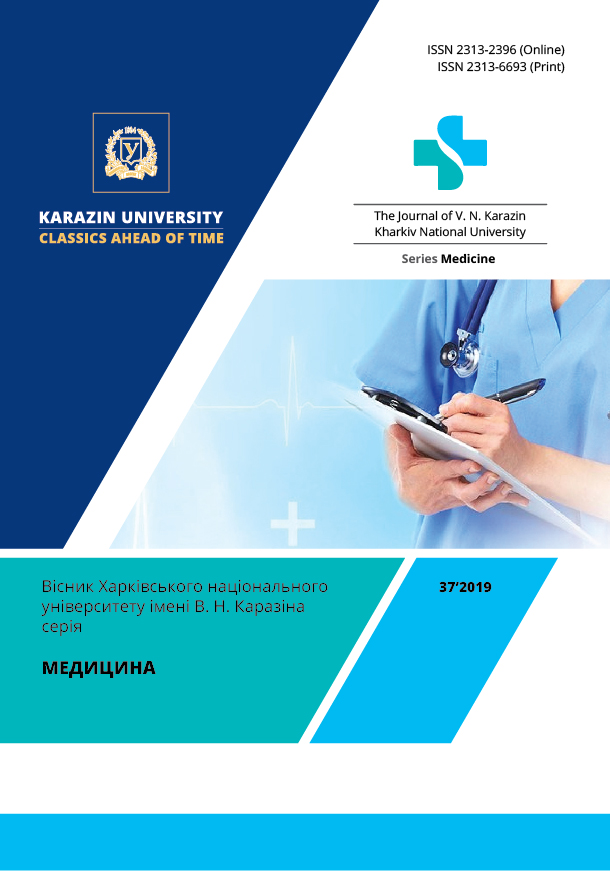Management of patient with famil ial combined hyperlipoproteinemia: a case study
Abstract
Familial combined hyperlipoproteinemia is considered one of the most common genetic hyperlipidemias in the general population with estimated prevalence 0.5 %–2.0 % of all inherited dyslipidemias. This disorder frequently coexists with other metabolic diseases such as obesity, insulin resistance, hypertension, non-alcoholic fatty liver disease. Association of hyperlipoproteinemia and type 2 diabetes mellitus can be explained due to the fact, that familial combined hyperlipoproteinemia is caused by genetic variability, including genes encoding the upstream transcription factor 1. The last regulates nearly 40 genes implicated in lipid, lipoprotein and carbohydrate metabolism, as well as immune response. Polymorphism in the upstream transcription factor 1 is strongly associated with dyslipidemia, impaired glucose tolerance, insulin resistance, and type 2 diabetes mellitus. In this report on example of clinical case we want to pay attention of practitioners to the problem of familial causes of hyperlipidemias, which leads to early onset of atherosclerosis, cardiovascular disease, and, finally, to premature disability of the affected person. Because of the frequent overlapping with the features of metabolic syndrome, this serious disorder is often not recognized and treated timely. Our patient was a 43 year old male, who was referred to the clinic with complaints of angina pain and dyspnoea provoked by minimal physical exertion, palpitations, irregular heartbeats, lower extremities and face oedema. At the age of thirty in the patient have developed type 2 diabetes mellitus, during last 7 years it was insulin dependent, the course was severe, glycaemia was poorly controlled by the therapy. Also he had essential hypertension III grade. At the age of 37 years the patient suffered from ST-elevated myocardial infarction, one year later occurred recurrent myocardial infarction. His family history was strongly positive for atherosclerosis and cardiovascular disease, as well as type 2 diabetes mellitus. In laboratory testing the fasting blood sample revealed a grossly lipemic serum, with total cholesterol level 17.75 mmol/L, very low density lipoproteins 3.41 mmol/L, low density lipoproteins 13.64 mmol/L, high density lipoproteins 0.7 mmol/L. Diagnosis: «Familial combined hyperlipoproteinemia (Fredrickson type 2B). Acute coronary syndrome: Unstable angina IIB. Postinfarction (STEMI 2014, 2015) cardiosclerosis. Essential hypertension III degree III stage. Heart failure with left ventricular systolic and diastolic dysfunction, EF 36 %. III functional class NYHA. Stage D AHA. Risk score 4 (very high).Type 2 diabetes mellitus, insulin dependent, severe course. Non-alcoholic fatty liver, 2 degree. Nodular goitre I degree, euthyroid state» was established. Management of this patient includes lifestyle modification and combined lipid lowering therapy in high doses: rosuvastatin and choline fenofibrate. Unfortunately, in this case target levels of cholesterol and triglycerides were not achieved: minimal level of total cholesterol was 12.29 mmol/L, and level of triglycerides was 41.48 mmol/L. Risk estimates based on risk charts, scores, or functions used in the general population, probably grossly underestimate the real risk of this patient with familial combined hyperlipoproteinemia. Coexistence of extremely high level of cholesterol and type 2 diabetes mellitus significantly aggravates and advances each other's course, comparing with the isolated disorders.
Downloads
References
Goff D. C. Jr Dyslipidemia prevalence, treatment, and control in the multi-ethnic study of atherosclerosis (MESA) / D. C. Goff Jr, A. G. Bertoni, H. Kramer [et al.]. // Circulation. – 2006. – No. 113. – P. 647–656.
Karr S. Epidemiology and management of hyperlipidemia / S. Karr. // The American Journal of Managed Care. – 2017. – V. 23, No. 9. – P.139–148.
Gaddi A. Practical guidelines for familial combined hyperlipidemia diagnosis: an up-date / A. Gaddi, A. Cicero, F. Odoo [et al.]. // Vascular health and risk management. – 2007. – No. 3. – P. 877–886.
Bello-Chavolla O. Y. Familial combined hyperlipidaemia: current knowledge, perspectives, and controversies / O. Y. Bello-Chavolla, A. Kuri-García, M. Ríos-Ríos [et al.]. // Revista de Investigación Clínica. – 2018. – No. 70. – P. 224–236.
Skoumas I. Impact of cardiometabolic risk factors on major cardiovascular events in patients with familial combined hyperlipidemia / I. Skoumas, C. Masoura, K. Aznaouridis [et al.]. // Circulation journal. – 2013. – No. 77. – P. 163–168.
Aguilar-Salinas C. Genetic and environmental determinants of the susceptibility of Amerindian derived populations for having hypertriglyceridemia / C. Aguilar-Salinas, T. Tusie-Luna, P. Pajukanta. // Metabolism. – 2014. – No. 63. – P. 887–894.
Brouwers M. The genetics of familial combined hyperlipidaemia / M. Brouwers, M. van Greevenbroek, C. Stehouwer [et al.]. // Nature reviews endocrinology. – 2012. – No. 8. – P. 352–362.
Sentinelli, F. Association of RXR-gamma gene variants with familial combined hyperlipidemia: genotype and haplotype analysis / F. Sentinelli, I. Minicocci, A. Montali [et al.] // Journal of Lipids. 2013. 2013:517943.
2016 ESC/EAS Guidelines for the management of dyslipidaemias / A. L. Catapano, I. Graham, G. D. Backer [et al.] // European heart journal. – 2016. – No. 37. – P. 2999–3058.
The Journal of V. N. Karazin Kharkiv National University, series Medicine has following copyright terms:
- Authors retain copyright and grant the journal right of first publication with the work simultaneously licensed under a Creative Commons Attribution License that allows others to share the work with an acknowledgement of the work’s authorship and initial publication in this journal.
- Authors are able to enter into separate, additional contractual arrangements for the non-exclusive distribution of the journal’s published version of the work, with an acknowledgement of its initial publication in this journal.
- Authors are permitted and encouraged to post their work online prior to and during the submission process, as it can lead to productive exchanges, as well as earlier and greater citation of published work.




